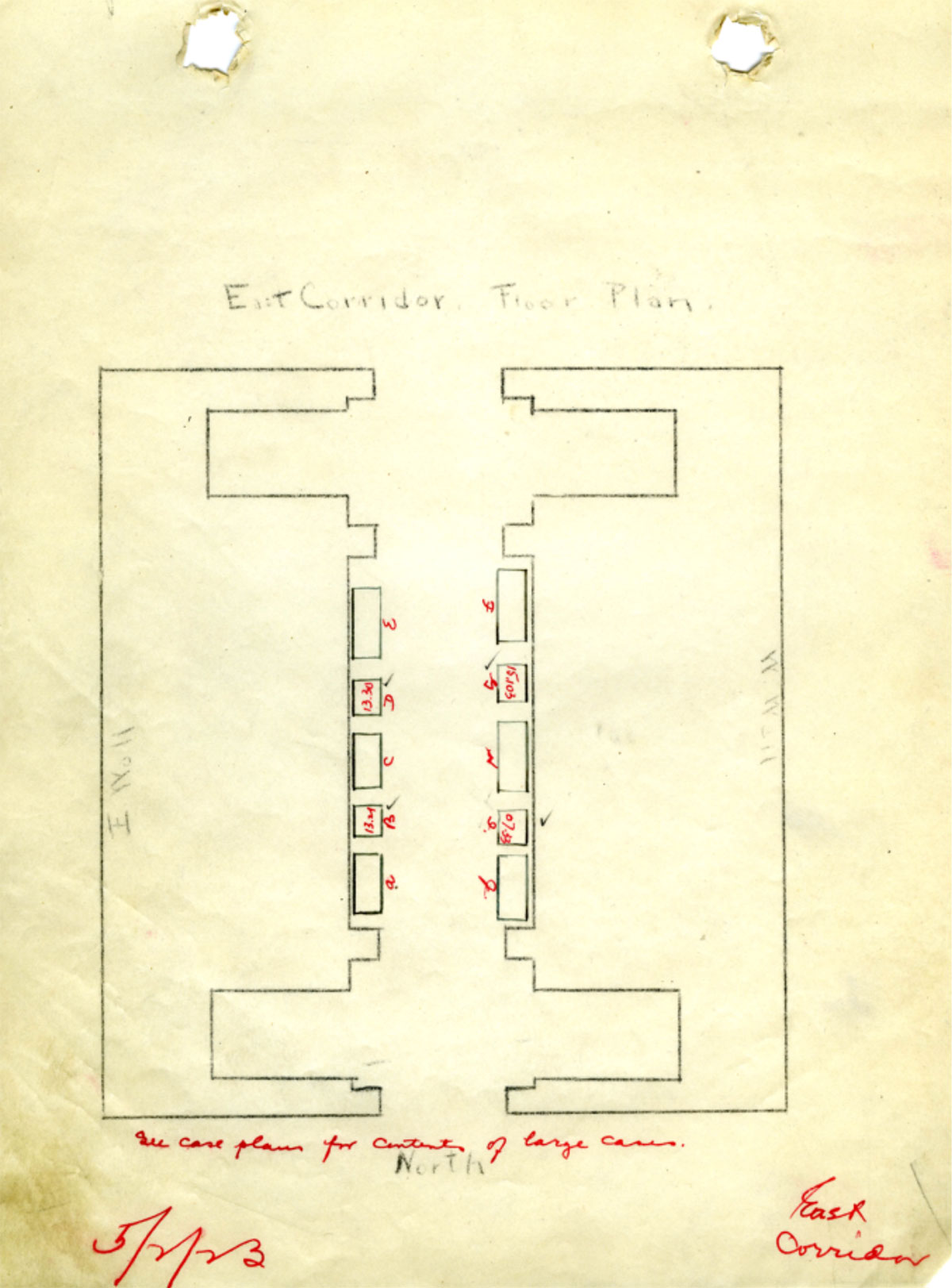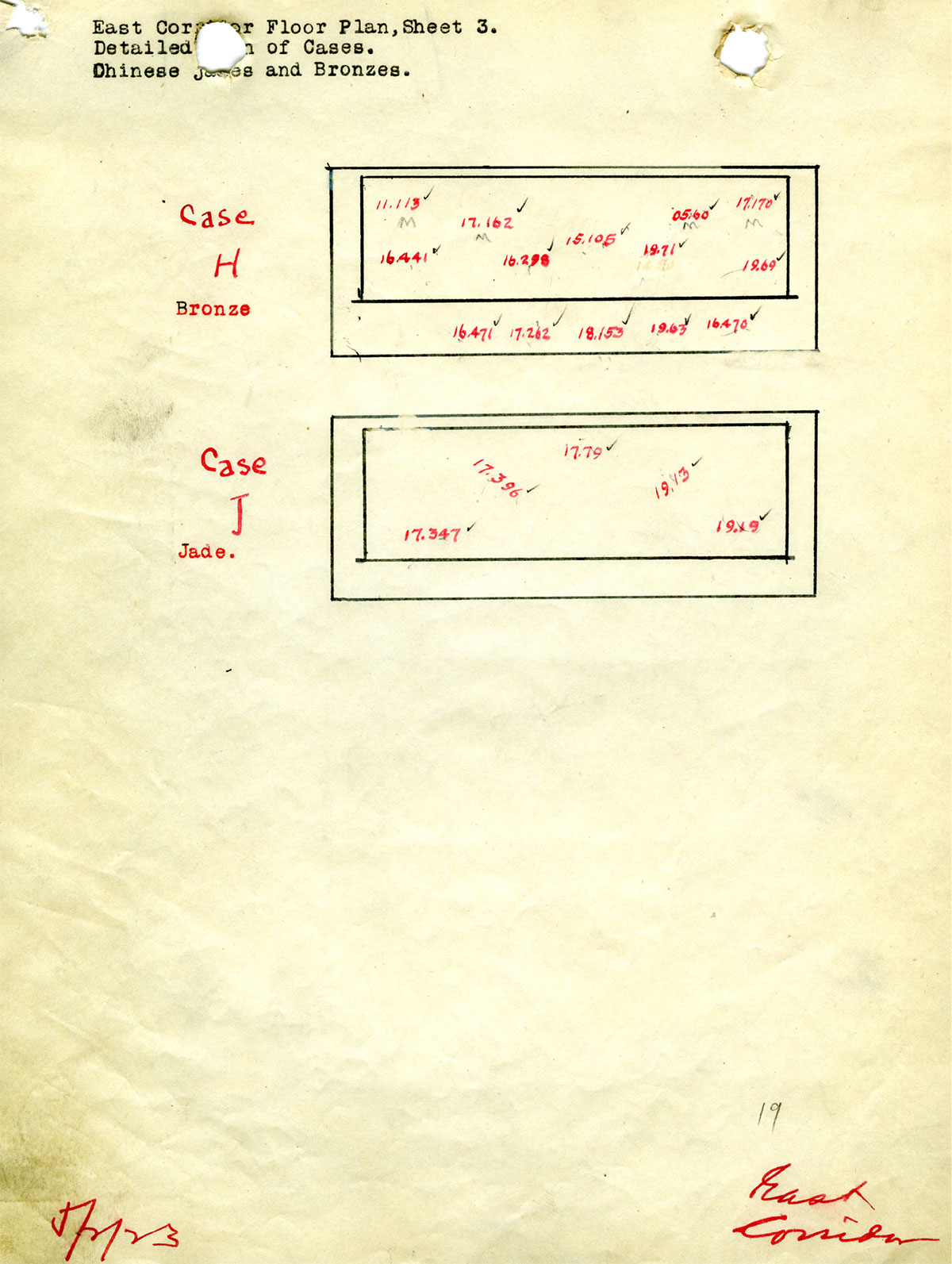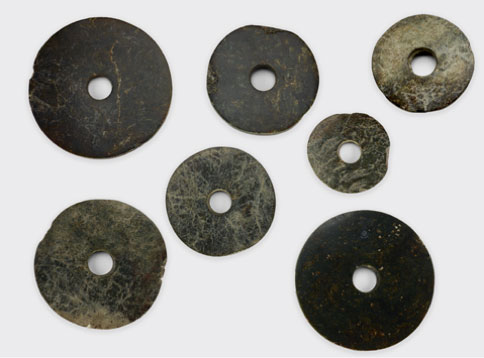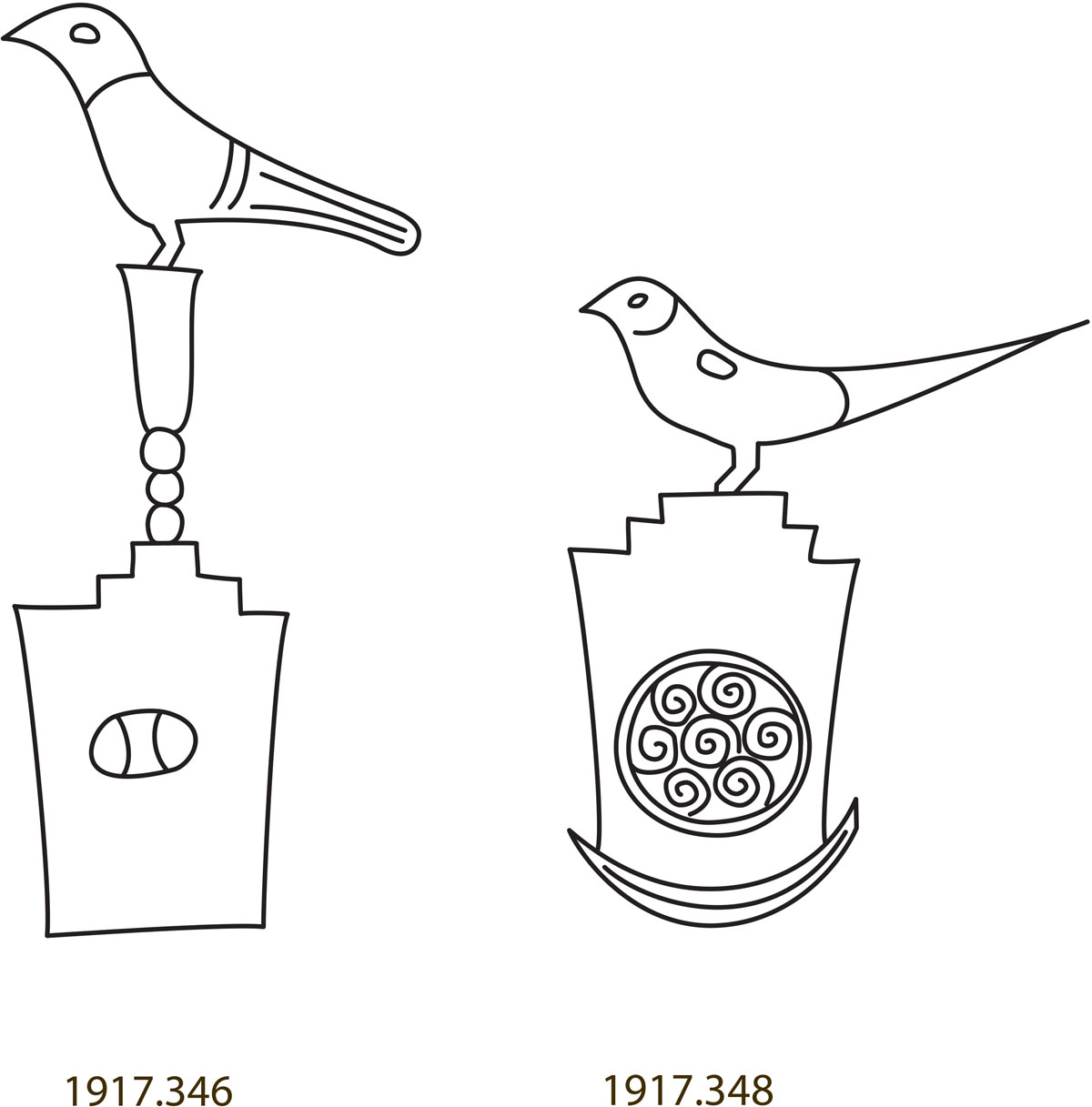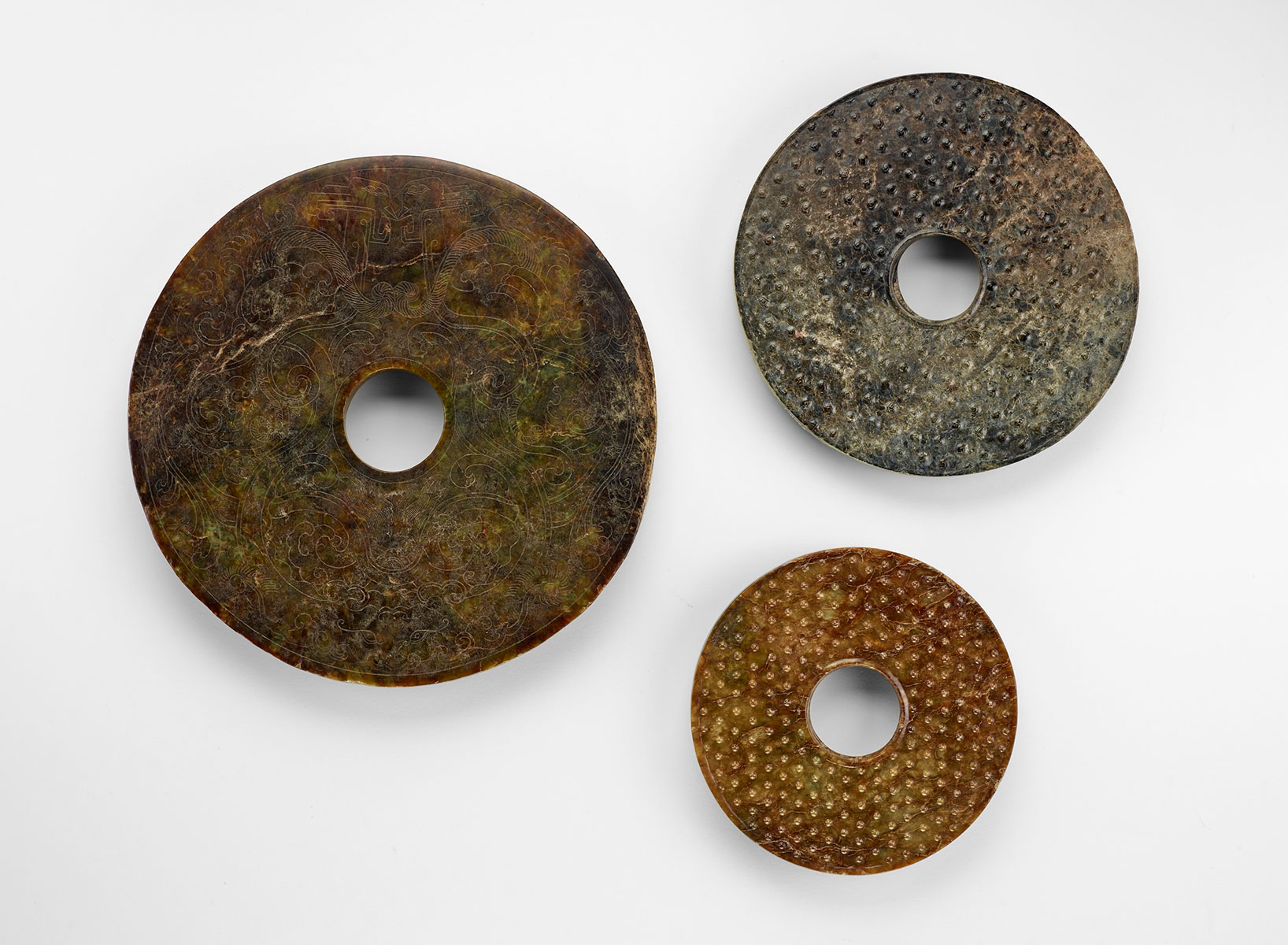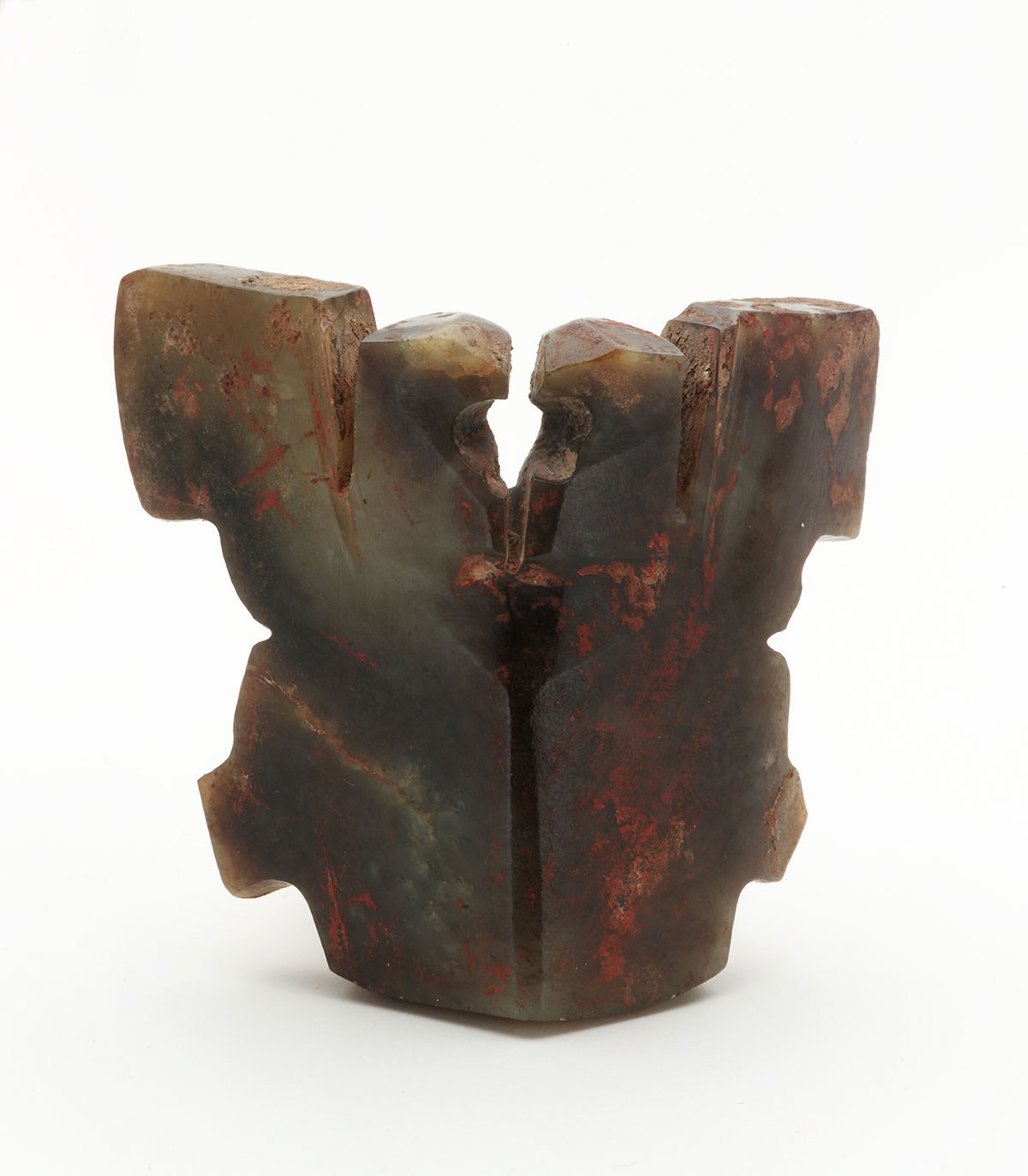Charles Lang Freer and His Collection of Neolithic Liangzhu 良渚 Culture Jades
Introduction
Beginning more than a century ago, the construction of railways and factories across China resulted in the chance discovery of ancient tombs. This was particularly true around the rapidly growing industrial centers of Shanghai 上海, Hangzhou 杭州, and Nanjing 南京 (fig. 1).[1] At the time, the precise age of the exposed graves was unknown, but the intriguing objects they yielded soon appeared on the international art market, chiefly in Shanghai 上海. Charles Lang Freer (1854–1919) purchased scores of these early pieces, especially jades.[2]
![Fig. 1 'Shanghai and Hangchow [Hangzhou],' 1927.](images/essays/wilson/Fig_1-thumb.jpg)
Ancient Chinese material culture has become better understood in the decades following the advent of scientific archaeology in China in the late 1920s. With controlled excavations, a remarkable number of early sites have been located, mapped, and analyzed. Consequently, the geographic distribution and chronological range of ancient Chinese objects have been documented with increased clarity. The resulting standards are helpful when evaluating collections like the one Freer formed in the opening years of the twentieth century. This is particularly true for jades, which were often vaguely or erroneously classified. Such research helps to outline the origins and growth of Freer’s jade collection, and it reveals that many of Freer’s jades were produced by the prehistoric Liangzhu 良渚 culture that flourished five thousand years ago (circa 3300–2250 BCE).
The Liangzhu 良渚 culture is now known as the most significant center for jade production in ancient China. It is associated with thousands of pieces of jewelry as well as with impressive but mysterious jade ritual objects found in burial sites between waterways in the lower Yangzi 揚子 River valley (now called Changjiang 長江 in China). In properly documented excavations, jade disks (bi 璧), tubes (cong 琮), and ceremonial tools are found close to corpses, which suggests they played a special role in burial rites.[3]
Building Freer’s Ancient Jade Collection
Charles Lang Freer acquired his first archaic Chinese jade in Shanghai 上海 in 1911 on his fifth and longest stay in China. He arrived on September 11, 1910, and departed on February 20 of the following year. As with his previous travels to Asia, Freer combined site visits and study with art purchases. Two highlights of this trip were the two weeks he spent surveying the Buddhist Caves at Longmen 龍門 (October 29–November 12, 1910) and a trip he took by houseboat from Shanghai 上海 to Hangzhou 杭州 and its West Lake (February 8–13, 1911; fig. 2).[4] He wrote in his diary for Wednesday, February 15, 1911: “Visited Chinese City [in Shanghai 上海] and searched for Han 漢 jade. Bought from [P]a Ku Cha and others.”[5]
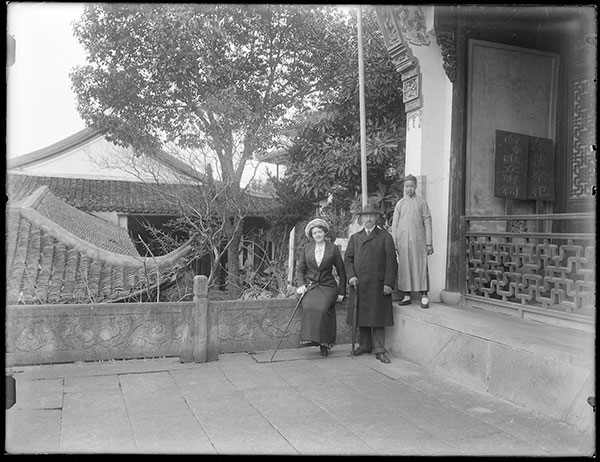
Records show Freer bought at least eighteen jades from Pa Ku Cha that day and paid $295 (about $7,500 in current value), a rather modest expenditure for him at the time. Although all of the objects were described as dating to the Han 漢 dynasty (206 BCE–220 CE), today we know none of the pieces was actually Han 漢. Most date to the Qing 清 dynasty (1644–1911), much later than it was believed. Freer did acquire one piece that was truly ancient, his first Neolithic Liangzhu 良渚 object (fig. 3). The rough, degraded disk was one of the more expensive objects he purchased from Pa Ku Cha. It cost him $40 (about $1,000 today).
Despite this first acquisition, Freer did not start buying jades in quantity for another five years. In fact, his collection of Neolithic jades was largely built between 1916 and his death in October 1919, a period when he added 152 works.
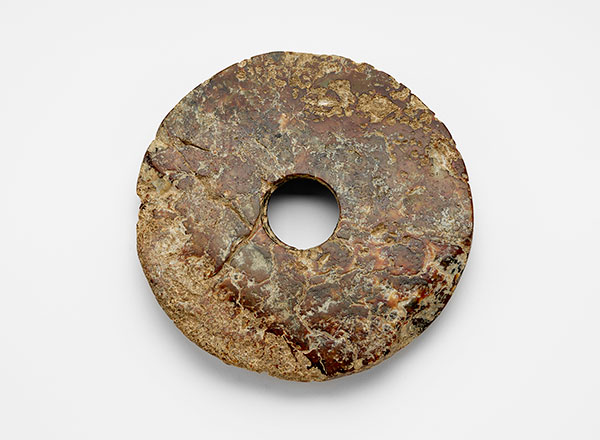
Freer relied primarily on dealers in China to supply him with early jades.[6] They or their agents brought things to him, but generally they sent photographs or objects for his consideration. Given Freer’s great distance from China, most of the acquisitions were made as bulk purchases for convenience. You Xiaoxi 游筱溪, Wang Jiantang 王鑑堂, and Li Wenqing 李文卿, his three top suppliers, were all based in Shanghai 上海 (table 1).[7] Together, they provided more than three-quarters of Freer’s ancient jades.
The dealer You Xiaoxi 游筱溪 was Freer’s most important source. Their relationship seems to have begun in 1916. You 游 sent Freer a copy of his sales catalogue Masterpieces in Chinese National Art, which included Chinese bronzes, jades, paintings, ceramics, and textiles.[8] Annotations in Freer’s copy of the catalogue, preserved in the Freer│Sackler Library, indicate he bought forty-one items for himself, including twenty-five jades. That was half of his jade purchases in 1916.[9] Likewise, he chose most of his 1919 jade acquisitions from a second catalogue that You 游 made for him. The only copy of the second catalogue, more like an informal scrap book, is preserved in the Freer|Sackler Archives.[10]

You 游 served as an important link to the family of Duanfang 端方 (1861–1911), the last viceroy of Qing 清 dynasty China. Duanfang had amassed an incomparable collection of antiquities during his lifetime.[11] Freer met Duanfang 端方 and viewed his collections several times in China. The last occasion was in October 1910 in Beijing 北京 just a year before the viceroy was murdered by his own troops in the opening days of the Xinhai 辛亥 Revolution that toppled the last Qing 清 emperor. Through You 游, Freer secured dozens of important jades from the heirs of Duanfang 端方. One was his most expensive Neolithic jade, a monumental ceremonial harvesting knife (hu 笏; fig. 4), which is one of the largest pieces to survive from ancient China. Freer bought it in 1918 for $6,050 (about $175,000 in current value).[12]
Freer rarely paid more than a thousand dollars for an ancient jade. In fact, only four other Neolithic pieces passed that cost threshold.[13] His average expenditure was about $250 (almost $6,500 in current value). The combined cost of all of Freer’s Neolithic jades was about $41,150, or almost $1.1 million today. On the current art market, this would be an unimaginable bargain.
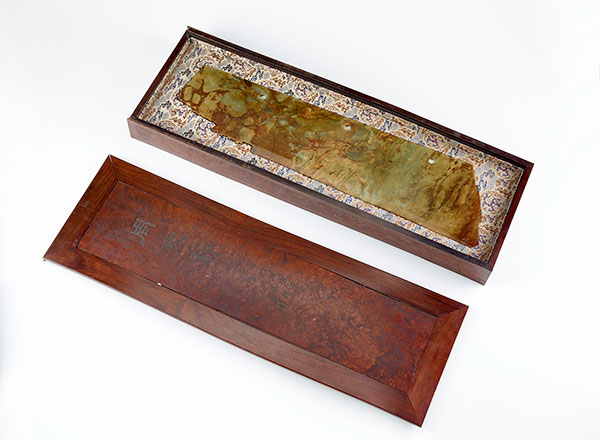
The objects Freer acquired span the range of jades that are now identified as Neolithic. Roughly half are flat disks or bi 璧 (61 pieces) and squared tubes (cong 琮) of various sizes (21 pieces). A second group includes objects inspired by functional stone tools, such as axes (fu 斧 or yue 鉞; 7 pieces), chisels (gui 圭; 5 pieces), zhang 璋 (thin blades with asymmetrically shaped tips that perhaps mimic functional agricultural tools; 11 pieces), and harvesting knives (hu 笏; 13 pieces). These objects should be regarded as ceremonial or symbolic in character. Bracelets (15), head ornaments (9), pendants (3), and beads (14) round out Freer’s collection.
Assessing the Collection: Early Antiquarian Studies
Chinese scholars assigned the traditional names bi 璧, cong 琮, and hu 笏 to these ancient objects. They relied upon written descriptions preserved in ancient ritual texts compiled during the Zhou 周 (circa 1050–256 BCE) and Han 漢 dynasties. Gu yu tukao 古玉圖考, or Illustrated study of ancient jades (fig. 5) was a highly respected product of this branch of traditional Chinese scholarship. Freer owned a copy of this book, which was written by the classically trained scholar Wu Dacheng 吳大澂 (1835–1902).[14].
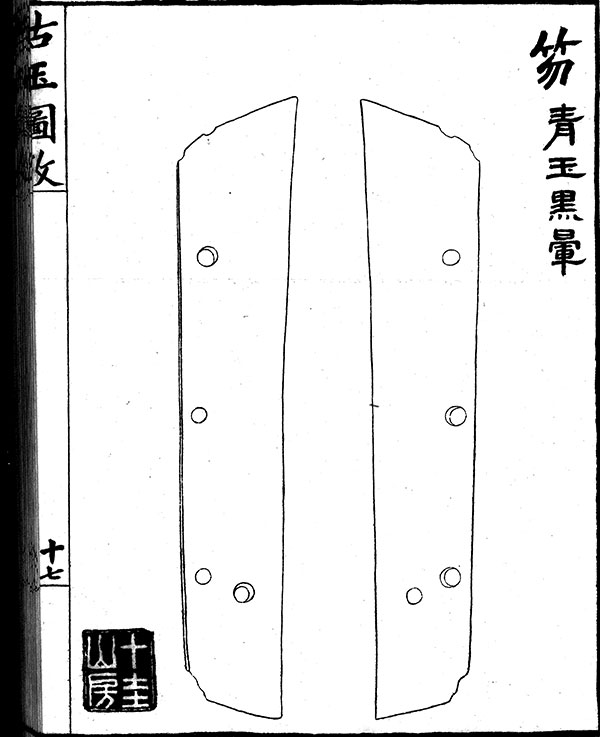
Berthold Laufer (1874–1934), a pioneering specialist in early Chinese culture at the Field Museum in Chicago and a protégé of Wu 吳, described Gu yu tukao 古玉圖考: “Pieces are illustrated in outlines . . . described as to their coloring, identified with their ancient names, and explained with quotations from literature.”[15] This approach influenced Laufer’s own work on Jade: A Study in Chinese Archaeology and Religion, published in 1912. Laufer wrote a personal inscription in Freer’s copy of the book. The two Chinese connoisseurs corresponded regularly and often visited one another during the 1910s.[16] Freer’s understanding of his collection was strongly influenced by Laufer and the traditional school of study they followed.
Misunderstandings sometimes arose when Wu 吳 and Laufer attempted to align written descriptions in old ritual texts with surviving artifacts. One example is the jade object (fig. 5) that resembles a harvesting knife (fig. 4). Laufer’s text, which was essentially a translation of Wu 吳, reports that such knife-shaped jades, called hu 笏, served as tablets for imperial writing. Both scholars claimed the holes were added so they could be worn or suspended on the wall. They also described the role inscribed jade tablets played in ancient ritual sacrifices.[17] Since such objects have been found almost exclusively in burials that predate the advent of Chinese writing by centuries, the interpretations offered by Wu 吳 and Laufer are anachronistic and no longer believed.
As recorded in sales receipts, dealers assigned their own dates to the objects Freer purchased. The broad range of pieces is rather evenly divided over 2,500 years and four dynastic periods (see table 2). This distribution does not reflect early attempts to define developmental sequences. Instead, it shows dealers viewed their objects differently. You Xiaoxi 游筱溪 generally considered his jades to be quite early and dated most of them to the Xia 夏 dynasty (traditionally 2205–1766 BCE). Li Wenqing 李文卿 assigned most of his objects to the Han 漢 dynasty, roughly two thousand years later. They are, however, similar in appearance.

The first public exhibition of Freer’s jades occurred at the Art Institute of Chicago from November 15 to December 8, 1917. It was initially intended to feature only a selection of his Chinese paintings, but in the months leading up to the event, the exhibition expanded to include eight of his Buddhist sculptures and thirty-four of his archaic jades.[18]
In the summer of 1917, Freer asked Laufer for his help in writing the introduction to the new sections. When that proved to be impossible within the compressed production schedule, those objects were not addressed in the general text or the section introductions. Laufer did, however, provide the dates assigned to individual objects in their catalogue entries.[19]
Works were placed in the Zhou 周 and Han 漢 dynasties, except for two pieces dated to the Imperial period. This, of course, corresponded with the presumed age of the ritual texts that were used to assign periods to the objects. Comparing descriptions in Freer’s shipping instructions with the Chicago catalogue text reveals two discrepancies. An axe blade (F1916.498) and a reworked fragment of a harvesting knife (F1916.490) were not assigned to the Xia 夏, as listed in the shipping documents, but instead were published as Zhou 周 objects in the catalogue. This may relate to the widespread belief among Western scholars, including Laufer, that China did not experience a Stone Age. That misconception forced them to compress developmental sequences.
An even larger issue was the apparent inability to distinguish between true antiquities and those objects that were made more recently but in an ancient style. One-third of the jades identified as archaic in the Chicago catalogue are now recognized as later archaistic works.[20] All in all, the Chicago exhibition illustrates how poorly archaic jades were understood a century ago.
Research and Exhibitions in the Opening Decades of the Freer Gallery of Art
The academic approach promoted by Wu Dacheng 吳大澂, Berthold Laufer, and other scholars influenced the research staff of the Freer Gallery of Art. The new museum opened to the public on May 2, 1923. Founding director John Ellerton Lodge (1878–1942) and early curators Carl Whiting Bishop (1881–1942) and Archibald Gibson Wenley (1898–1962) utilized the antiquarian’s methods, and the notes they made in individual object files (now called Curatorial Remarks) draw heavily from Gu yu tukao 古玉圖考 and Laufer’s Jade.[21]
The first jade exhibitions in the Freer Gallery differed markedly from the 1917 exhibition in Chicago.[22] In the inaugural installation, fifty jades were shown together with thirty ancient bronzes. Although the exhibition labels no longer exist, installation diagrams illustrate that the jades, presented in four cases, surveyed a longer time span than the Chicago show, and they did so with a generally accurate, if largely intuitive, separation of truly ancient and later examples (fig. 6). Thus, two of the cases featured many of the pieces now recognized as Neolithic, while the other two contained masses of examples with surface decoration associated with later revivals.
From very early on, the staff of the museum actively sought to broaden both the scope and the character of the jade collection beyond Freer’s bequest. This pursuit of diversity was no doubt hastened by the first important excavations of early sites by trained Chinese archaeologists in the late 1920s and 1930s. Particularly noteworthy were the finds at Anyang 安陽, the last capital of the Shang 商 dynasty (circa 1300–1050 BCE) and the first ancient Chinese site to yield historical writing.[23] Work at sites from the Eastern Zhou 周 period (770–256 BCE) also revealed new material. The chance finds at the Warring States (475–221 BCE) cemetery at Jincun 金村 were particularly exciting for scholars worldwide. As comparable objects began to appear on the art market, the Freer Gallery acquired them in large quantities, and installations of the new acquisitions soon began to dominate displays dedicated to ancient China.
The latest archaeological findings provided the basis for increasingly accurate historical and contextual studies as well as a clearer sense of stylistic evolution over time. The prehistoric period was still poorly understood, however, so many of the objects that Charles Lang Freer purchased from his Shanghai 上海 dealers in the 1910s continued to be difficult to date with confidence. In many developmental sequences, they were still placed after the Anyang 安陽 period, not before it.
Archibald Gibson Wenley repeated this misunderstanding in the first publication of the Freer Gallery’s jades, which appeared in The Scientific Monthly in 1946.[24] The article resulted from a fresh review of the Freer Gallery’s Chinese jade collection and the initiation of technical studies, chiefly specific gravity tests to identify the stone. In almost all cases, it proved to be nephrite, which was also true of the jades being unearthed in China. Wenley made a useful attempt to discover traditional workshop practices through careful physical examination of the artifacts. He also acknowledged the existence of a Stone Age in China.
The Impact of Neolithic Archaeology and the Emerging Recognition of the Liangzhu 良渚 Culture
In the decades following the end of World War II, the Chinese civil war (1927–50), and the establishment of the Peoples Republic in 1949, archaeological surveys led to a quickening pace of targeted excavations across China. Chance finds and salvage projects also occurred, as the construction of factories and housing accompanied the development of New China. Brief reports of the most important or promising finds began to appear in dedicated scholarly journals, such as Wenwu 文物 (Cultural Relics) and Kaogu 考古 (Archaeology).Neolithic discoveries were especially welcome since so many questions about the prehistoric period existed. With the excavation of Stone Age sites in various locations across China, archaeologists showed that distinctive societies co-existed, thus refuting the prevailing model that theorized a single sequence of progressively more sophisticated northern Chinese cultures, beginning in Henan 河南 province, ultimately yielded the Bronze Age. A surprising range of late Neolithic material became increasingly clear with the resumption of archaeological publications after the Cultural Revolution (1966–76).
Beginning in the late 1970s, more than three decades after Wenley’s study, enough new information had been published to encourage a second review of the museum’s early jade collection. In a process that continues to this day, increasing numbers of Charles Lang Freer’s purchases have been reassigned to the Neolithic period, much earlier than originally believed. With the archaeological identification of specific regional societies, many pieces can now be associated with the Longshan 龍山 (circa 3000–1700 BCE)[25], Qijia 齊家 (circa 2250–1900 BCE)[26], and Sanxingdui 三星堆 (circa 2000–1000 BCE)[27] cultures.[28] The largest share of the collection, however, is now associated with the Liangzhu 良渚 culture (see table 3).

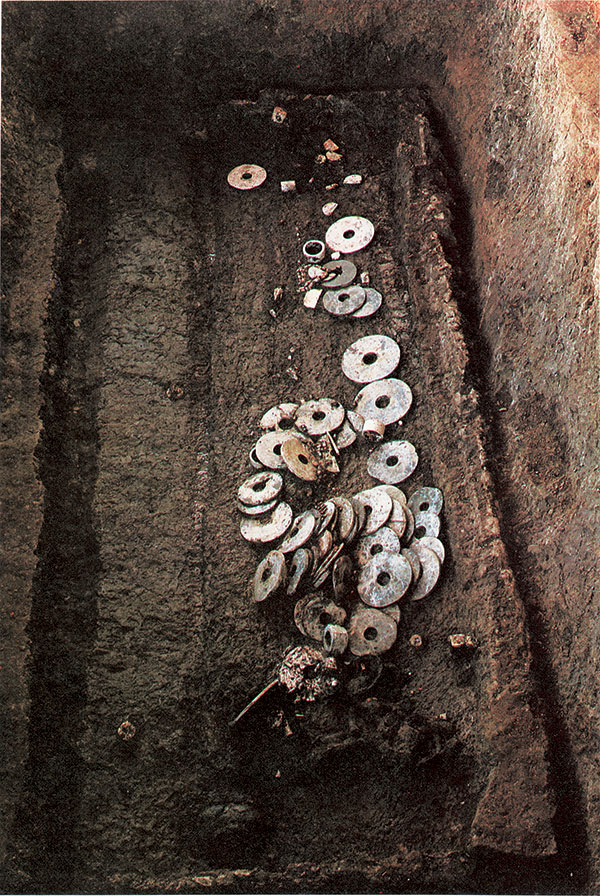
The Liangzhu 良渚 culture takes its name from the location of the first documented excavations that resulted in the definition of the characteristic artifacts associated with the people. As described in Liu Bin’s 劉斌 essay, these excavations took place in the mid-1930s in the modern town of Liangzhu 良渚, in Zhejiang 浙江 province, near the city of Hangzhou 杭州.[29] Scholars initially associated the Liangzhu with black pottery Neolithic centers located farther north, but beginning in 1959 the growing number of sites was increasingly seen as an independent society and was formally labeled “Liangzhu 良渚 culture.”[30]
A series of surprising finds in the decades since the late 1970s revealed the Liangzhu 良渚 culture was a flourishing Stone Age society with extremely rich elite burials.[31] These finds, concentrated in the Lake Tai 太湖 region of coastal central China, spread from Shanghai 上海 two hundred miles west to Nanjing 南京. Some Liangzhu 良渚 burials contain dozens or even scores of ritual objects, chiefly disks (bi 璧) and square tubes (cong 琮), ceremonial axes (fu 斧), and various kinds of personal adornment (fig. 7).[32] Given the richness of Liangzhu 良渚 burials, such as Fanshan 反山 Tomb M23, which contained more than two hundred objects, it seems possible that the Liangzhu 良渚 objects Freer purchased during a relatively short period of time may actually represent the contents of just a few burials.
Freer Gallery of Art and Liangzhu 良渚 Exhibitions and Publications
Liangzhu 良渚 objects in the Freer collection were identified through careful comparisons with recently excavated material. Julia Murray, a specialist in Chinese art at the Freer Gallery from 1979 to 1983, celebrated the first results of this research in the exhibition Ancient Chinese Jade, which was on view from September 4, 1980, to March 6, 1981. Including nearly one hundred fifty objects, the survey presentation began with the newly identified Liangzhu 良渚 jades and ended with material from the early Imperial period, which for the first time placed the Neolithic pieces in their proper place in the historical sequence. The primary catalyst for the exhibition may have been the publication of the Neolithic finds from Caoxieshan 草鞋山.[33] Murray’s notes in individual object files attest to the impact this excavation had on her collection study.
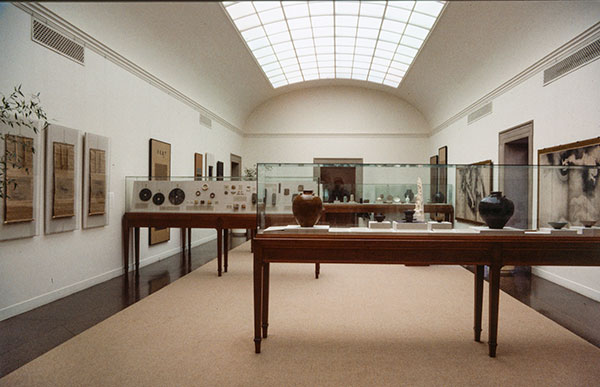
A refinement of the 1980 presentation of the Liangzhu 良渚 collection came two years later as a chapter in Studies in Connoisseurship: 1923–1983, an exhibition presented at the Freer Gallery from September 23, 1983, to March 1, 1984 (fig. 8). This exhibition was created to celebrate the sixtieth anniversary of the Freer Gallery of Art. According to an accompanying article in Orientations magazine, the plan was to demonstrate “the ways in which the understanding of works of art has changed with continuing scholarly investigation.”[34]
Murray introduced a number of the most important examples before concluding the article with a prescient hope.
As the spades of Chinese archaeologists continue to unearth ancient material, which forms the basis of comparison with objects in museums and private collections, we may be able to retrieve additional jades from the later periods to which they may have been incorrectly assigned. Furthermore, as scientifically excavated jades continue to increase in number, they may provide us with a basis for establishing typological sequences for long-enduring shapes such as bi and [c]ong. Perhaps mineralogical analyses performed on excavated jades will also provide information that will aid us in pinpointing the origins of different types of stone used in various periods. Research on Neolithic jades may be expected to see great advances in the coming years.[35]
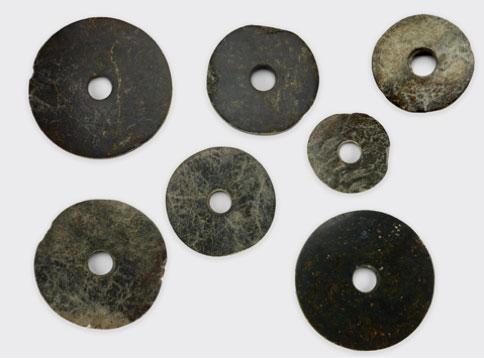
The new finds in China also encouraged Murray to search old purchase records for information about the purported geographic origins of objects in Charles Lang Freer’s collection. As it turned out, You Xiaoxi 游筱溪, the museum founder’s largest source of Neolithic jades, seems to have supplied possibly accurate reports for several dozen of the jades he sold to Freer. You 游 associated them with small towns near modern Liangzhu 良渚, northwest of Hangzhou 杭州, which is now seen as the geographic center of the culture.[36] For example, when he bought seven bi 璧 disks in 1917 (fig. 9), Freer was told they came from Anxi 安溪, Zhejiang 浙江.
Two of the disks in the group—shown here at the upper left and lower right—carry rare inscriptions that are incised on one of their flat sides (fig. 10).[37] In each case, the shallow, incised designs feature a bird depicted in profile standing on a stepped geometric base that contains what might be a solar symbol. The elements are rendered in thin, even lines that are extremely difficult to create in the hard medium of nephrite. Such pictographic inscriptions probably signify clan identity. Although they cannot be called true writing, a similar pictorial approach is evident in the earliest known Chinese written characters.
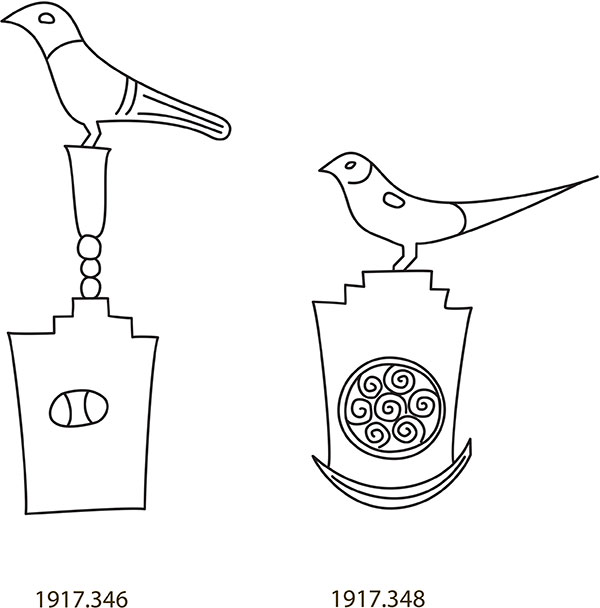
Less than ten inscribed Liangzhu 良渚 disks (whole or fragmentary) and cong 琮 tubes have been unearthed in the past fifty years under controlled conditions in China.[38] Surprisingly, one of the inscribed disks possesses a mark with a stepped frame and solar symbol that is similar to the two Freer disks (fig. 10). That disk is also said to have been unearthed in Anxi 安溪. Although the precise circumstances of its discovery are unknown, it was reportedly found in 1989.[39] Discoveries such as this one have helped reconnect museum objects with ongoing archaeology in China.
The bond between scientific excavations and the Freer collection provided the subject for the most recent collection display, which was informally named “Liangzhu 良渚 and its Legacy” and was on view from November 4, 2010, through January 3, 2016. The exhibition featured forty Liangzhu 良渚 objects that were compared with the output of other Neolithic jade-using cultures and later Bronze Age works that they inspired. View this installation in an interactive tour produced by the Google Cultural Institute.
Conclusion
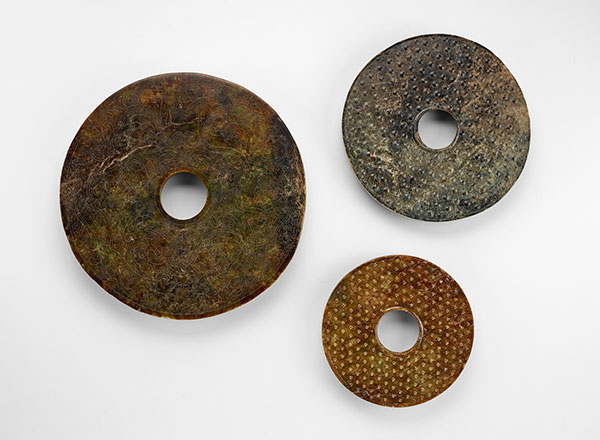
Although the works addressed here belong to an “heirloom collection” that was acquired a century ago without a detailed record of archaeological contexts, they continue to possess great value for contemporary scholarship, for they illustrate a past age of discovery and an earlier pattern of collecting. As key objects in ongoing research on ancient China, many have been published in studies of Confucian rituals, cultural and art history, and geology and material science. Freer objects have also played an active role in amplifying the results of ongoing archaeology in China.[40]
A final method of study involves using archaeological standards as well as an understanding of materials and workshop methods to identify Liangzhu 良渚 and other Neolithic jades that may have been recycled, that is, repurposed, reshaped, or redecorated, in more recent times (fig. 11).
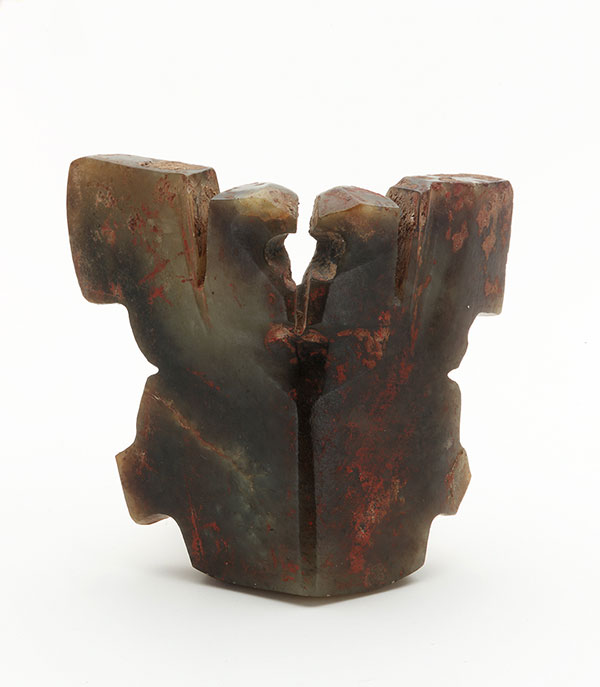
For each disk, the jade material corresponds to the type that is customarily encountered among Liangzhu 良渚 objects. The workmanship—with holes drilled from two sides, resulting in perforations with a visible ridge about halfway through—is also associated with Liangzhu 良渚 products. The surface decoration, however, reflects much later standards. Raised hemispherical bumps on the two small bi 璧 were inspired by models from the late Warring States and early Han 漢 periods some two millennia after the Neolithic source. The archaizing designs of masks and birds on the largest disk can be traced to illustrations in Qing 清 catalogues of ritual objects. In all three cases, the surface ornament was apparently added to the ancient jades in the late nineteenth or early twentieth century in an effort to make plain objects more appealing on the antiquities market.
One mask-like ornament illustrates a much earlier form of reuse (fig. 12). Fashioned from recognizable Liangzhu 良渚 nephrite, this piece apparently represents the corner of a Neolithic cong 琮 tube. The markings of the original corner of the Liangzhu 良渚 form are on the front face, while the reverse bears a sector of the round channel that was originally bored through the middle of the tube. This design now resembles late Anyang 安陽 or early Western Zhou 周 taotie 饕餮 animal mask motifs found on bronzes and jades. In the Early Bronze Age, a Neolithic ritual form was likely trimmed for reuse perhaps because the original was damaged or had lost it meaning.
These final examples reveal the enduring value of the stone itself and its “remarkable talent for survival,” which the well-known scholar Jessica Rawson has described in poetic terms.
Jade has a remarkable talent for survival, a quality that has been overlooked at its most practical level. . . . The endurance of jade ensured that individual pieces survived over extraordinary periods of time, being reused and reinterpreted in later eras. . . . This capacity for survival far exceeds that of metals or ceramic, both of which are much more easily broken into indistinguishable small pieces or melted down.[41]
Notes
[1] This map is included in the Carl Whiting Bishop Papers in the Freer Gallery of Art and Arthur M. Sackler Gallery Archives, Smithsonian Institution, Washington, D.C.
[2] A total of 253 Neolithic and Neolithic-style Chinese jades in the Freer Gallery of Art and Arthur M. Sackler Gallery are included in the first “volume” of this digital catalogue. Freer purchased 163, or almost 70 percent, of them himself. They are supplemented by seven important gifts from his protégés, the financier and newspaper publisher Eugene Meyer (1875–1959), and his wife, Agnes Meyer (1887–1970), who worked closely with Freer to tailor a collection that resonated with his. Many of their objects entered the Freer Gallery’s collection after their deaths. The Gallery acquired nine other purchases and gifts after Freer’s death. Seventy-one related works are in the Arthur M. Sackler Gallery. Jades contributed by John Gellatly (1852–1931), a contemporary of Freer who donated his eclectic collection of American, European, and Asian art to the Smithsonian’s National Gallery of Art in 1929, are also included in this volume since his three remarkable fittings from the Neolithic Shijiahe 石家河 culture (circa 2500–2000 BCE) have been on loan to the Sackler Gallery since 1985.
[3] See the essay by Liu Bin 劉斌, Deputy Director of the Zhejiang 浙江 Institute of Cultural Heritage and Archaeology, on the history of Liangzhu 良渚 archaeology.
[4] Freer’s travels to Asia are summarized in Thomas Lawton and Linda Merrill, Freer: A Legacy of Art (Washington, DC: Freer Gallery of Art, 1993), 59–97. For a discussion of his final Chinese sojourn, see David Hogge, “Freer’s Longest Trip to China, 1910–1911,” Arts of Asia 41, no. 5 (September–October 2011), 122–34. Freer’s diary entries written during his time at Longmen 龍門 in 1910 have recently been published in Chinese in Huo Dawei 霍大爲, Wang Yiyou 王伊悠, and Li Wen 李雯, Foguang wu liang 佛光無盡 (Shanghai: Shanghai shuhua chubanshe, 2014). The text is illustrated with photographs taken during the trip.
[5] Freer’s diaries are kept in the Archives of the Freer Gallery of Art and Arthur M. Sackler Gallery. Since no paper records issued on Pa Ku Cha stationery are known to survive, the characters representing the firm’s name (and thus its proper Pinyin 拼音 Romanization) remain a mystery. See Charles Lang Freer Papers, Freer Gallery of Art and Arthur M. Sackler Gallery Archives, Smithsonian Institution, Washington, D.C. Gift of the estate of Charles Lang Freer. Series 3 Diaries. Found online at http://sova.si.edu/record/FSA.A.01
[6] Writing to the pioneering Chinese anthropologist Berthold Laufer at Chicago’s Field Museum on January 19, 1918, Freer noted the new activity of “foreign dealers” in New York, but he suggested they had little real importance. See Charles Lang Freer Papers, Freer Gallery of Art and Arthur M. Sackler Gallery Archives, Smithsonian Institution, Washington, D.C. Gift of the estate of Charles Lang Freer. Series 2 Correspondence. Found online at http://sova.si.edu/record/FSA.A.01
[7] Chinese dealers and other figures mentioned in this text frequently chose idiosyncratic, personal spellings to Romanize their Chinese names. To introduce a level of consistency, Pinyin 拼音 Romanization has been adopted as the standard in this essay. Self-styled conventions are included to help the reader connect individuals with historical documents.
[8] Yue Seaouke [You Xiaoxi] 游筱溪, Masterpieces in Chinese National Art: The Collection of Mr. Seaouk’e Yue (Shanghai: Commercial Press, 1916).
[9] Freer’s marked copy of You’s 游 catalogue also reflects his penchant for passing objects to friends as purchase suggestions or gifts. In this instance, several friends are mentioned, including Louisine Havemeyer (1855–1929), to whom Freer gave an archaistic jade, and Agnes Meyer, who purchased six Chinese paintings. In addition, he designates twelve Chinese paintings for the Arden Gallery, an indication he also placed objects with commercial concerns.
[10] See Charles Lang Freer Papers, Freer Gallery of Art and Arthur M. Sackler Gallery Archives, Smithsonian Institution, Washington, D.C. Gift of the estate of Charles Lang Freer. Series 2 Correspondence. Found online at http://siris-archives.si.edu/ipac20/ipac.jsp?&profile=all&source=~!siarchives&uri=full=3100001~!290153~!0#focus
[11] For a useful study of Duanfang 端方 and his relationship with Freer, see Thomas Lawton, “Tuan-fang, 1861–1911” in A Time of Transition: Two Collectors of Chinese Art, Franklin D. Murphy Lectures XII (Lawrence, KS: Spencer Museum of Art, University of Kansas, 1991), 5–63.
[12] This blade has been extensively published since the year after Freer purchased it. In sources issued before the late 1980s, it was variously dated to the Shang 商 dynasty through the Eastern Zhou 周 period (770–221 BCE); beginning with Hayashi Minao 林巳奈夫, it has been assigned to the Neolithic, usually the Longshan 龍山 culture. See Katherine Nash Rhoades, “Recent Additions to the Freer Collection,” Art and Archaeology 8, no. 5 (September–October 1919), 284–85; Alfred Salmony, Carved Jade of Ancient China (Berkeley: Gillick Press, 1938), pls. 7:3, 8:1; Umehara, Sueji 梅原末治, Shina kogyoku zuroku 支那古玉圖錄 (Kyōto: Kuwana bunseidō, 1955), pl. 48; Na Zhiliang 那志良, Yuqi tongshi 玉器通釋 (Hong Kong, 1964–70), vol. 2, pl. 14; William Willetts, Foundations of Chinese Art from Neolithic Pottery to Modern Architecture (New York: McGraw-Hill, 1965), color pl. 7; William Watson, Early Civilization in China (London: Thames and Hudson, 1966), 75, fig. 58; Geoffrey Wills, Jade of the East (New York: Weatherhill, 1972), pls. 19–20; Doris Dohrenwend, “Jade Demonic Images from Early China,” Ars Orientalis 10 (1975), 62, figs. 32, 40; Hayashi Minao 林巳奈夫, “Sen In shiki no gyokki bunka 先殷式の玉器文化,” Museum 334 (January 1979), fig. 10; Na Zhiliang 那志良, Yuqi cidian 玉器辭典 (Taibei: Wenwen chubanshe, 1982), vol. 2, 196, no. 1729; Hayashi Minao 林巳奈夫, “Inkyo Fukō bo shutsudo no gyokki jakkan ni taisuru chūshaku 殷墟婦好墓出土の玉器若干に對する注釋,” Tōhō gakuhō 東方學報 58 (1986), fig. 2; Lawton and Merrill, Freer: A Legacy of Art, fig. 141; Jessica Rawson, Chinese Jade from the Neolithic to the Qing (London: British Museum, 1995), 45–46, 184–85; Elizabeth Childs-Johnson and Gu Fang, The Jade Age: Early Chinese Jades in American Museums (Beijing: Kexue chubanshe, 2009), 184–85; and J. Keith Wilson, “Thinking Green: Chinese Jades Reworked in the Second Millennium BCE,” Transactions of the Oriental Ceramic Society 77 (2012–13), figs. 2–3.
[13] According to bills of sale, he paid $2,025 each for a tall cong 琮 tube (F1916.410) and a chisel with mask and bird designs (F1915.87); and $1,010 each for a disk (F1916.381) and zhang 璋 forked blade (F1915.69).
[14] Wu Dacheng 吳大澂, Gu yu tukao 古玉圖考 (Shanghai: Tongwen shuzhu, 1889). At least three of Freer’s Neolithic jades were formerly owned by Wu 吳: one important short cong 琮 tube or bracelet (F1917.384) and two bi 璧 disks (F1919.20 and F1919.27). Wu 吳 is the subject of a recent article by Chen Shen; see “Timeless Destinations: Stories of the People behind Wu Dacheng’s Jade Cang Bi,” Orientations 47, no. 3 (April 2016), 26–33.
[15] Berthold Laufer, Jade: A Study in Chinese Archaeology and Religion, Anthropological Series 10 (Chicago: Field Museum of Natural History, 1912), 13.
[16] Regular correspondence between the two men is preserved in the Freer|Sackler Archives. See Charles Lang Freer Papers, Freer Gallery of Art and Arthur M. Sackler Gallery Archives, Smithsonian Institution, Washington, D.C. Gift of the estate of Charles Lang Freer. Series 2 Correspondence. Found online at http://collections.si.edu/search/results.htm?view=&dsort=&date.slider=&fq=data_source%3A%22Freer+Gallery+of+Art+and+Arthur+M.+Sackler+Gallery+Archives%22&fq=object_type%3A%22Collection+descriptions%22&q=FSA+A.01
[17] Wu’s 吳 description appears on the pages following the illustration (18a–19a); Laufer’s translation can be found in Jade on page 116.
[18] Art Institute of Chicago, A Loan Exhibition of Ancient Chinese Paintings, Sculptures, and Jade Objects from the Collection Formed by Charles Lang Freer (Chicago: Art Institute of Chicago, 1917), cat. nos. 84–117. Although installation photographs showing galleries dedicated to paintings survive, pictures illustrating the arrangement of the jades have not been found.
[19] Elinor Pearlstein, “Ancient Chinese Jade Through the Sonnenschein Lens, 1900–1935,” Transactions of the Oriental Ceramic Society 78 (2013–14), 73.
[20] The exhibition included the following archaistic pieces inspired by earlier styles: F1911.445, F1915.52, F1917.47, F1917.62, F1913.13, F1917.20, and F1917.138.
[21] This is particularly true for the ceremonial tools and weapons. See, for example, the Curatorial Remarks left in the object files by Lodge, Bishop, and Wenley for two harvesting knives (F1916.244 and F1918.1.1) and two zhang 璋 blades (F1916.162 and F1916.492).
[22] For an analysis of early Chinese art displays in the Freer, see J. Keith Wilson, “Then and Now: Displaying Chinese Art at the Freer Gallery,” Arts of Asia 41, no. 5 (September–October 2011), 135–47.
[23] The Freer Gallery and Museum of Fine Arts, Boston, cosponsored the first two seasons of excavations at Anyang 安陽 (1928–29). Work at the extremely important site has continued with few interruptions to this day. For a useful survey of the early period of work at Anyang 安陽, see Li Chi, Anyang (Seattle: University of Washington Press, 1977).
[24] A. G. Wenley, “Early Chinese Jade,” Scientific Monthly 63 (November 1946), 341–47.
[25] For example, see the following Longshan 龍山objects in Freer’s collection: F1918.1.1 (harvesting knife), F1915.87 (chisel), F1916.491, F1916.166, F1916.162, F1916.492, F1916.164, F1916.494, and F1916.495 (forked blades).
[26] Freer bought one Qijia 齊家cong 琮 tube (F1917.41) and one bi 璧 disk (F1912.40).
[27] Freer owned two Sanxingdui 三星堆disks: F1919.31 and F1919.59.
[28] Additional Neolithic cultures are represented among purchases made by the staff of the Freer Gallery of Art; more are included in the Arthur M. Sackler Gallery.
[29] See, for example, Xihu bowuguan 西湖博物館 and Wu Yue shidi yanjiuhui 吴越史地研究會, Hangzhou Gudang xinshiqishidai yizhi zhi shitan baogao 杭州古荡新石器时代遺址之試探報告 (Hangzhou, 1936); He Tianxing 何天行, Hangxian Liangzhu zhen zhi shiqi yu heitao 杭縣良渚鎮之石器與黑陶 (Wu Yue shidi yanjiuhui congshu 吳越史地研究會叢書) (Shanghai: Wu Yue shidi yanjiuhui, 1937); Shi Xingeng 施昕更, Zhejiang sheng Xihu bowuguan 浙江省西湖博物館, Liangzhu: Hangxian dierqu heitao wenhua yizhi chubu baogao 良渚:杭县第二區黑陶文化遺址初步報告 (Hangzhou: Zhejiang sheng jiaoyuting, 1938).
[30] The leading archaeologist Xia Nai 夏鼐 (1910–1985) was the first to advocate calling the remains “Liangzhu 良渚 culture”; he did this in an unpublished paper presented at a conference on Yangzi 揚子 Valley archaeology on December 26, 1959.
[31] See, for example, Nanjing bowuyuan 南京博物院, “Jiangsu Wuxian Caoxieshan yizhi 江蘇吳縣草鞋山遺址,” Wenwu ziliao congkan 文物資料叢刊 3 (1980), 1–24; Nanjing bowuyuan 南京博物院, “Jiangsu Wujin Sidun yizhi de shijue 江蘇武進寺墩遺址的試掘,” Kaogu 考古 1981.3, 193–200; Shanghai shi wenwu baoguan weiyuanhui 上海市文物保管委員會, “Shanghai Fuquanshan Liangzhu wenhua muzang 上海福泉山良渚文化墓葬,” Wenwu 文物 1984.2, 1–5; and the summaries provided in Zhejiang sheng wenwu kaogu yanjiusuo 浙江省文物考古研究所, Shanghai shi wenwu guanli weiyuanhui 上海市文物管理委員會, and Nanjing bowuyuan 南京博物院, Liangzhu wenhua yuqi 良渚文化玉器 (Beijing: Wenwu chubanshe, and Xianggang: Liangmu chubanshe, 1989); and Hayashi Minao 林巳奈夫, “Ryōsho bunka no gyokki jakkano megutte 良渚文化の玉器若干をめぐって = Jade of the Liang-chu Culture,” Museum 360 (1981), 22–33.
[32] The illustrated burial, among those with the most objects, is discussed in Zhejiang sheng wenwu kaogu yanjiusuo 浙江省文物考古研究所, Fanshan 反山 (Liangzhu yizhiqun kaogu baogao, vol. 2 良渚遺址群考古報告之二) (Beijing: Wenwu chubanshe, 2005), vol. 1, 298–343, and vol. 2, color pls. 1076–1219.
[33] Nanjing bowuyuan 南京博物院, “Jiangsu Wuxian Caoxieshan yizhi 江蘇吳縣草鞋山遺址,” Wenwu ziliao congkan 文物資料叢刊 3 (1980), 1–24.
[34] Julia Murray, “Neolithic Chinese Jades in the Freer Gallery of Art,” Orientations 14, no. 11 (1983), 16.
[35] Murray, “Neolithic Jades,” 21–22.
[36] The purported sources for some of Freer’s jades are illustrated on the map featured in the “Places” unit of this catalogue.
[37] The two inscribed disks are F1917.346 and F1917.348. Freer also bought two other inscribed Liangzhu 良渚disks (F1917.79 and F1919.58) and a Liangzhu 良渚 bracelet with two inscriptions (F1917.385). The Freer Gallery recently purchased from a Meyer family member an inscribed Liangzhu 良渚 cong 琮 tube (F2016.2) that was once in the collection of Eugene and Agnes Meyer.
[38] The Taiwan-based scholar Deng Shuping 鄧淑蘋 has published extensively on inscribed Liangzhu 良渚 objects, and most of the surviving examples in heirloom collections along with those scientifically excavated are included in her “Liangzhu yuqi shang de shenmi fuhao 良渚玉器上的神秘符號,” Gugong wenwu yuekan 故宮文物月刊 = The National Palace Museum Monthly of Chinese Art 117 (1992), 26–47, and “Zhongguo xinshiqi shidai yuqi shang de shenmi fuhao 中國新石器時代玉器上的神秘符號,” Gugong xueshu jikan 故宮學術季刊 = National Palace Museum Research Quarterly 10, no. 3 (1993), 1–50. Her more recent thoughts are summarized in English in “Incised Emblems on Ritual Jades of the Liangzhu Culture,” in Xiaoneng Yang, ed., New Perspectives on China’s Past: Chinese Archaeology in the Twentieth Century (New Haven: Yale University Press, 2004), 171–85.
[39] See Zhongguo yuqi quanji bianji weiyuanhui 中國玉器全集編輯委員會, Zhongguo yuqi quanji 中國玉器全集 (Shijiazhuang: Hebei meishu chubanshe, 1992), nos. 229–31. The disk is now in the Zhejiang 浙江 Provincial Museum.
[40] The most recent major publication to include a large sampling of archaic jades in the Freer and Sackler collections is Elizabeth Childs-Johnson 江伊莉 and Fang Gu 古方, Yuqi shidai: Meiguo bowuguan cang Zhongguo zaoqi yuqi 玉器時代:美國博物館藏中國早期玉器= The Jade Age: Early Chinese Jades in American Museums (Beijing: Kexue chubanshe, 2009).
[41] Rawson, Chinese Jade, 22–23.

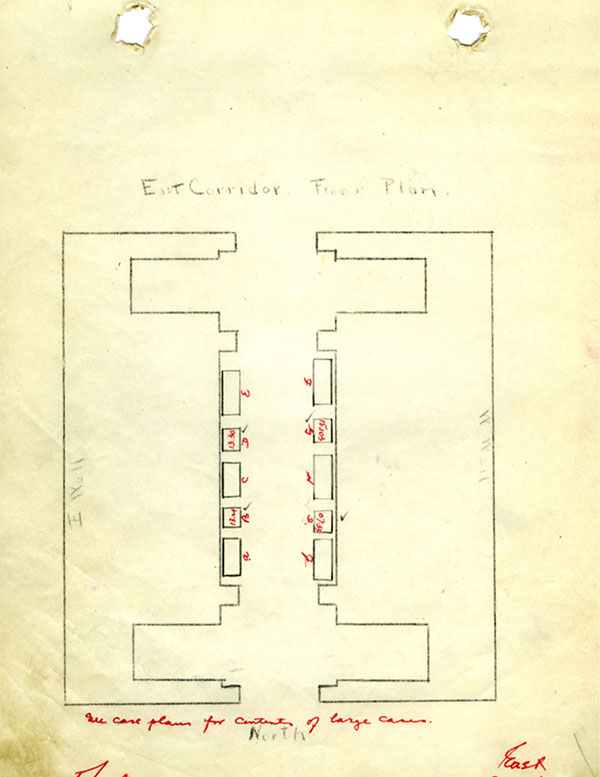
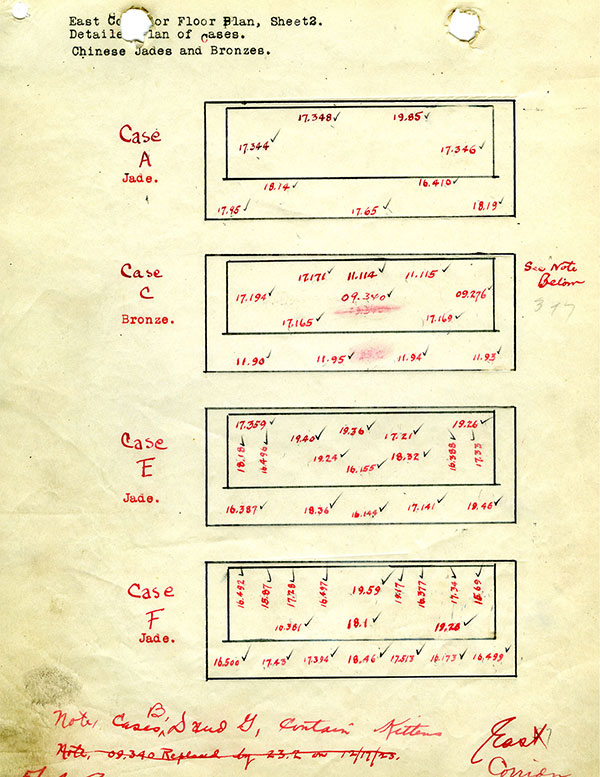
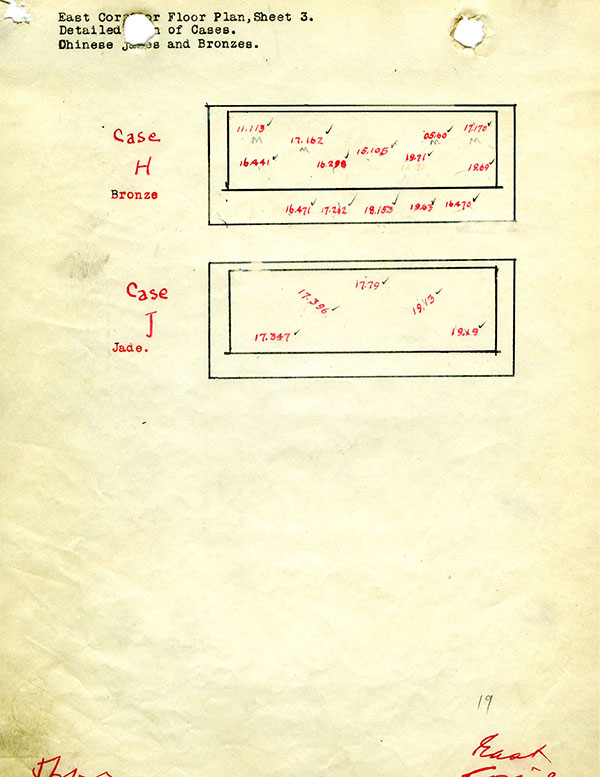
![Figure 1 - Shanghai and Hangchow [Hangzhou]](images/essays/wilson/Fig_1.jpg)




